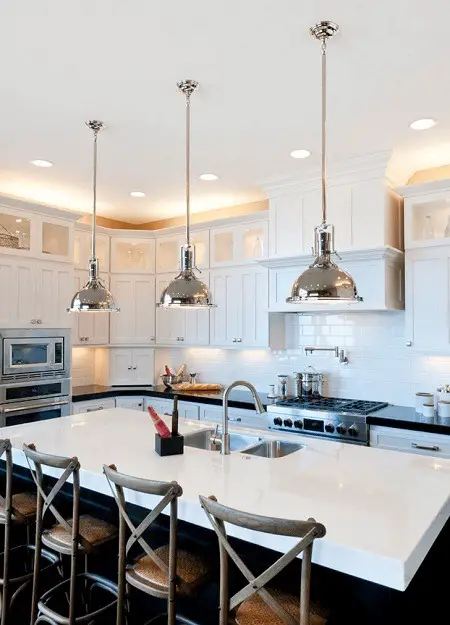15 Useful Tips on How to Declutter Your Kitchen
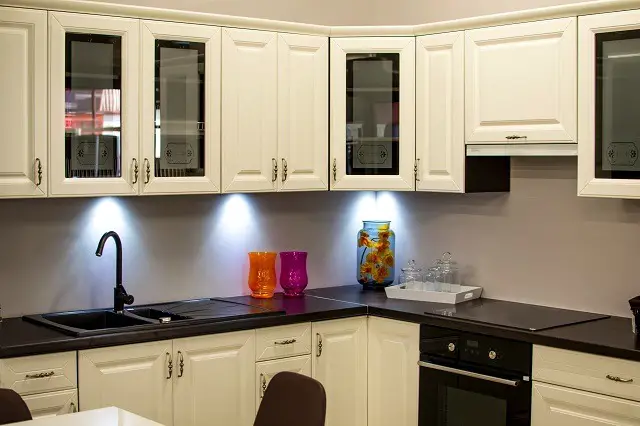
Most people will agree that the most essential room in your house is the kitchen. You could argue that your bedroom is the most important room, until you try sleeping on a hungry stomach.
Your kitchen is where you spend time preparing food for yourself, friends and loved ones. It should be a fun experience to cook and share your homemade food with others.
However, the fun may turn to stress if you are preparing food from a cluttered kitchen.
While your kitchen needs to be an area where you prepare and eat food, it can easily become a dropping point for things in the house.
You and your loved ones will walk into the kitchen to get something to munch, and leave behind items such as toys, keys, mail and other miscellaneous things.
Before you know it, clutter has entirely covered the kitchen counters.
Knowing where to begin is the first stage to decluttering the kitchen. You should have a plan ready before you start the process of decluttering.
Understanding why you should declutter your kitchen will also motivate you to do it.
It can be overwhelming dealing with such a huge project; however, knowing where to begin can help in keeping you focused and on course.
Having a plan will help in making sure your kitchen stays decluttered for a long time, which is the intended goal.
Specific tips on how to declutter your kitchen
Here are some tips to declutter the kitchen:
-
Get rid of unwanted and extra bakeware, cookware and dishes
Most people own an assortment of random, onetime dishes in the cupboard. It is normal to find kitchens with old rusty cookware that should have been disposed years back.
The clutter could include plates and dishes that belong to neighbors, family, or friends gathered over many years of events sharing meals.
Immediately free up space in the cabinets by removing these unwanted items, together with any other irrelevant cups, bowls and plates. You should also get rid of other dishes that don’t serve you anymore.
This will apply to hardly used and old bakeware. Update to a few good saute pans and toss away the set of scratched up non-stick skillets.
Forget about disappointment of trashing old dishes! Keeping away the utensils can be essentially simpler when you have sufficient room for arranging them.
Cramming everything on top of the other on the kitchen shelves will simply not work and is not sustainable
-
Decluttering the food storage containers cabinet
This can be a huge task based on how cluttered the cabinet is and the size of your assortment.
Begin by looking for any damaged or stained plastic storage containers and dispose them.
After doing that, match the remaining lids with the containers that remained to make sure each container has a lid. Dispose of any containers that do not have lids.
Just like purchasing the whole set of pans but just use a few, do you purchase the sizes you require or whole sets of food storage containers?
If you have unused food storage containers, throw them away or give away those that are in good condition.
-
Designating a bin for counter mess
Clutter will easily build up on the counters. Put a small bin in the kitchen.
Make it clear to everybody in your house that clutter will only go into the bin, and not onto the countertops.
In the end, go through your bin and get things back to their correct place or dispose those that amount to garbage.
-
Organizing the junk drawer
This type of drawer is good for keeping items you need but have no place for. You need to get a drawer organizer.
Separate things into categories, which makes it simpler to find them when you require them. Do not hesitate to send any trash from your junk drawer right into the trash bin.
-
Dispose of anything chipped or broken
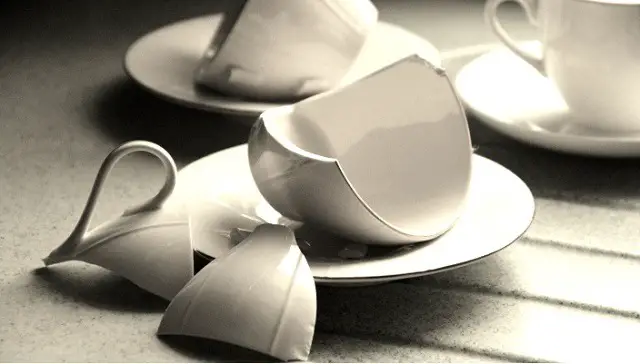
You should go through everything in the kitchen and remove everything that’s chipped or broken. Broken things have no place in your house and are just occupying space.
It is hazardous to have chipped plates and glasses since the chips disclose sharp edges that can harm someone.
In addition to being hazardous, these items are an eye sore. Make sure you dispose them to make room for useful and new aesthetically appealing items
-
Dispose of extra or unused kitchen appliances
It is very easy to get used to purchasing all the small appliances and gadgets meant to make your life simpler in your kitchen. The gadgets will fast build-up and occupy all the space in your kitchen.
Take the time to go through all the gadgets. Do you use them regularly or at all? Does the appliance simplify your life?
Can you purchase it again if you were doing the purchase currently? If your answer is no, it is time to dispose it off.
-
Limiting your number of cookware
While it might be convenient to have 6 different pans of all sizes and shapes, it is truly not essential. Limit yourself to 2 pans and 2 to 3 pots.
Make sure your cookware varies in size so you are not missing anything important.
However, unless the kitchen operates as a restaurant, four or five cookware items should be enough to suit your needs.
-
Storing smart
You should be smart about where you are storing the kitchen appliances and items. If you’re using an appliance every day, such as a toaster or coffee maker, it has to sit out on the countertop.
On the other hand, if you use something once weekly, you can store it inside a cupboard or on a shelf.
To reduce clutter in the kitchen even more, if you own an item such as a turkey roaster which you only use once yearly, place it in the basement or storage unit.
This can help you save lots of space and let you move more items off of the counters and into the kitchen storage.
If you want to declutter even more, sort through the kitchen and remove the things you don’t require.
This can save you lots of room in the kitchen and can very much minimize clutter.
-
Declutter similar things together
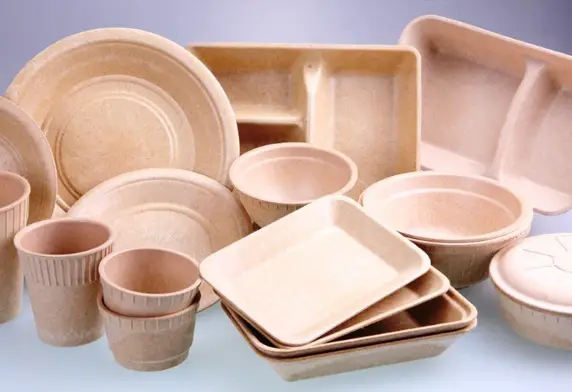
This is the best method of decluttering, as you gather all similar things together and declutter them at one time.
For instance, gather all the serving dishes together, check what you have and dispose of what you do not love, require or use.
After that, perform the same with your baking ware, your mugs, your dishes, etc. until you’ve decluttered every category of things in the kitchen.
The advantages of this technique are that you are able to see everything you have of every kind of item at once.
This will make it easier for you to know just what you have and declutter what you don’t need. You also get to apply a similar fair standard for the same category of items.
The disadvantage of this technique is that it might not be as convenient or fast if you have to gather things from multiple areas in the kitchen.
-
Dish towels
You should throw away dish towels which are past their prime. Assess the remaining towels to check if you require and use them all.
Otherwise, donate them or utilize them for rags if they aren’t in the best shape for donating.
-
Declutter the countertops
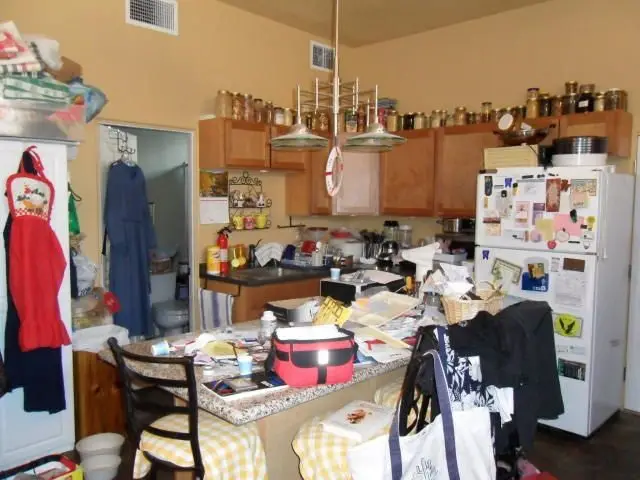
If your kitchen counter space is small, think about storing away small appliances you do not use regularly in cupboards.
The rooms with less space are the easiest to appear the most cluttered.
Countertops are quite simple and fast to declutter as many of the items belong in the garbage, another room or in one of the cabinets.
You should group everything in the cabinet together, serving bowls, glasses, plates, mugs, etc. By doing this, when you require something, you know just where to get it.
When most people are decluttering their kitchen, they realize how many additional non-matching pots, coffee mugs and tupperware containers they have and do not require.
These are superb items for donating. Consider it, will you use all of them or are they simply occupying space? If your answer is the latter, it is time to give and do so cheerfully!
-
Decluttering the food cabinets and pantry
Food cabinets and pantry can turn out to be an area of forgotten food. Items get buried beneath or shoved in the back of other things.
You can begin by checking for expired stuff and dispose them. Get rid of any food you most likely will not eat and donate them or throw if expired or almost expired.
You will be shocked by the amount of wasted food you can get by cleaning up the pantry. Picture all those unused, but expired bottles of canned goods, spices or salad dressing.
The expired or unused food that you end up throwing away is a good indication of foods you should not buy in the future. It is also a good guide of the appropriate quantities to buy to avoid wastage.
-
Maximize your food items
Remember that food, for the most part, is costly, and with the economy today, nobody wants to waste it.
When you have food thrown in the refrigerator or the pantry, not under any category, it’s difficult to have control over what you need to be use first.
You should group the kinds of food like fresh items, boxed items, canned goods, etc, with the oldest food items in front so you use them first. I
f you know the product expiration date of each food item, you are in control over what products you need to use first.
-
Decluttering the linen drawer
You should check what’s in your kitchen’s linen drawer. Trivets, pot holders, kitchen towels, and oven mitts are usually hidden from view until you really require them.
Dispose of any torn or burnt oven mitts and pot holders. You should also dispose of towels and dish rags that are worn, tattered, stained or torn.
Remember to look at drawers for unused, damaged or broken trivets and get rid of these items.
-
Decluttering the freezer and refrigerator
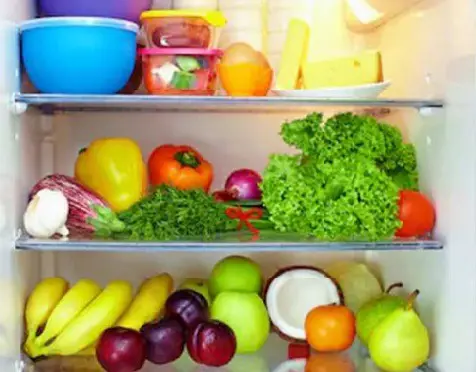
Your kitchen decluttering exercise cannot be complete without going through the refrigerator.
Look at expiration dates of all the sauces and seasoning, and then combine all the half-empty containers.
Look at all bottles of leftovers and throw away any that are very old. Many leftovers are just good for 2 to 3 days.
You should also sift through your cheese, veggies, fruits and meat drawers and throw away any foods that have exceeded their useful life
Remember to go through the freezer and look at every item for expiration dates and freezer burn, then dispose of anything that’s gone bad or which is unlikely to be consumed before it goes bad.
Final thoughts
Keep in mind, cleaning up and organizing the kitchen is simpler than you think.
These essential tips can help you declutter your kitchen (even a small kitchen) and keep it looking clean with the least effort and time.
To crown it all, ensure that you finalize your kitchen decluttering exercise with a thorough clean up of whichever area you have decluttered.

